NSB102 Nursing Analysis: Dementia as a Healthcare Issue in Australia
VerifiedAdded on 2023/03/23
|14
|3643
|55
Essay
AI Summary
This essay presents a nursing analysis of dementia as a significant healthcare issue in Australia. It examines different types of healthcare delivery models, including health promotion, disease prevention, and long-term care, specifically in the context of dementia. The analysis delves into the social determinants of health, focusing on the impact of poverty on dementia patients, and explores the importance of cultural safety and person-centered care, addressing issues like ageism. Furthermore, the essay emphasizes the role of nurses in providing ethical and culturally sensitive care, adhering to professional codes and standards to improve the quality of life for dementia patients in Australia. This document is available on Desklib, a platform offering study tools and resources for students.
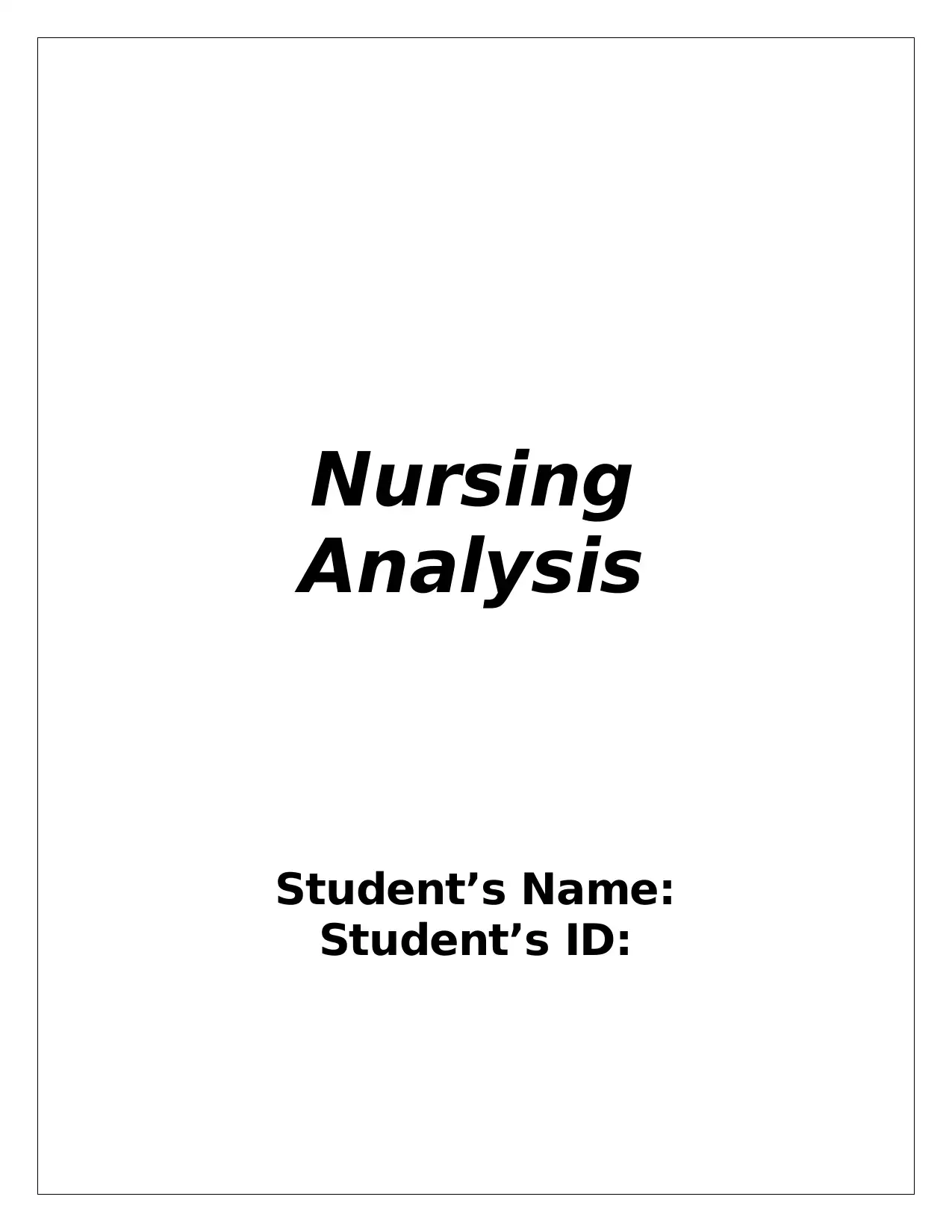
Nursing
Analysis
Student’s Name:
Student’s ID:
Analysis
Student’s Name:
Student’s ID:
Paraphrase This Document
Need a fresh take? Get an instant paraphrase of this document with our AI Paraphraser
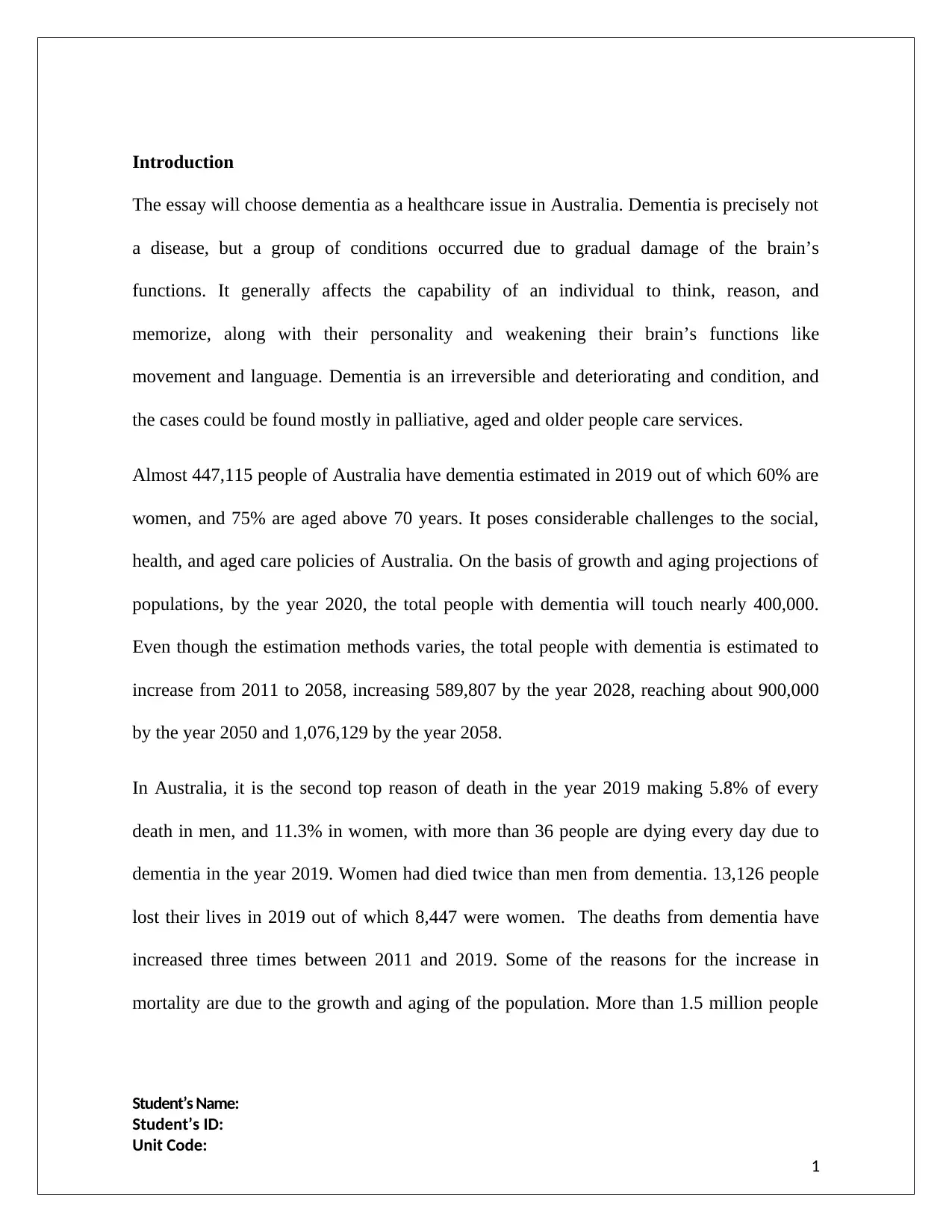
Introduction
The essay will choose dementia as a healthcare issue in Australia. Dementia is precisely not
a disease, but a group of conditions occurred due to gradual damage of the brain’s
functions. It generally affects the capability of an individual to think, reason, and
memorize, along with their personality and weakening their brain’s functions like
movement and language. Dementia is an irreversible and deteriorating and condition, and
the cases could be found mostly in palliative, aged and older people care services.
Almost 447,115 people of Australia have dementia estimated in 2019 out of which 60% are
women, and 75% are aged above 70 years. It poses considerable challenges to the social,
health, and aged care policies of Australia. On the basis of growth and aging projections of
populations, by the year 2020, the total people with dementia will touch nearly 400,000.
Even though the estimation methods varies, the total people with dementia is estimated to
increase from 2011 to 2058, increasing 589,807 by the year 2028, reaching about 900,000
by the year 2050 and 1,076,129 by the year 2058.
In Australia, it is the second top reason of death in the year 2019 making 5.8% of every
death in men, and 11.3% in women, with more than 36 people are dying every day due to
dementia in the year 2019. Women had died twice than men from dementia. 13,126 people
lost their lives in 2019 out of which 8,447 were women. The deaths from dementia have
increased three times between 2011 and 2019. Some of the reasons for the increase in
mortality are due to the growth and aging of the population. More than 1.5 million people
Student’s Name:
Student’s ID:
Unit Code:
1
The essay will choose dementia as a healthcare issue in Australia. Dementia is precisely not
a disease, but a group of conditions occurred due to gradual damage of the brain’s
functions. It generally affects the capability of an individual to think, reason, and
memorize, along with their personality and weakening their brain’s functions like
movement and language. Dementia is an irreversible and deteriorating and condition, and
the cases could be found mostly in palliative, aged and older people care services.
Almost 447,115 people of Australia have dementia estimated in 2019 out of which 60% are
women, and 75% are aged above 70 years. It poses considerable challenges to the social,
health, and aged care policies of Australia. On the basis of growth and aging projections of
populations, by the year 2020, the total people with dementia will touch nearly 400,000.
Even though the estimation methods varies, the total people with dementia is estimated to
increase from 2011 to 2058, increasing 589,807 by the year 2028, reaching about 900,000
by the year 2050 and 1,076,129 by the year 2058.
In Australia, it is the second top reason of death in the year 2019 making 5.8% of every
death in men, and 11.3% in women, with more than 36 people are dying every day due to
dementia in the year 2019. Women had died twice than men from dementia. 13,126 people
lost their lives in 2019 out of which 8,447 were women. The deaths from dementia have
increased three times between 2011 and 2019. Some of the reasons for the increase in
mortality are due to the growth and aging of the population. More than 1.5 million people
Student’s Name:
Student’s ID:
Unit Code:
1
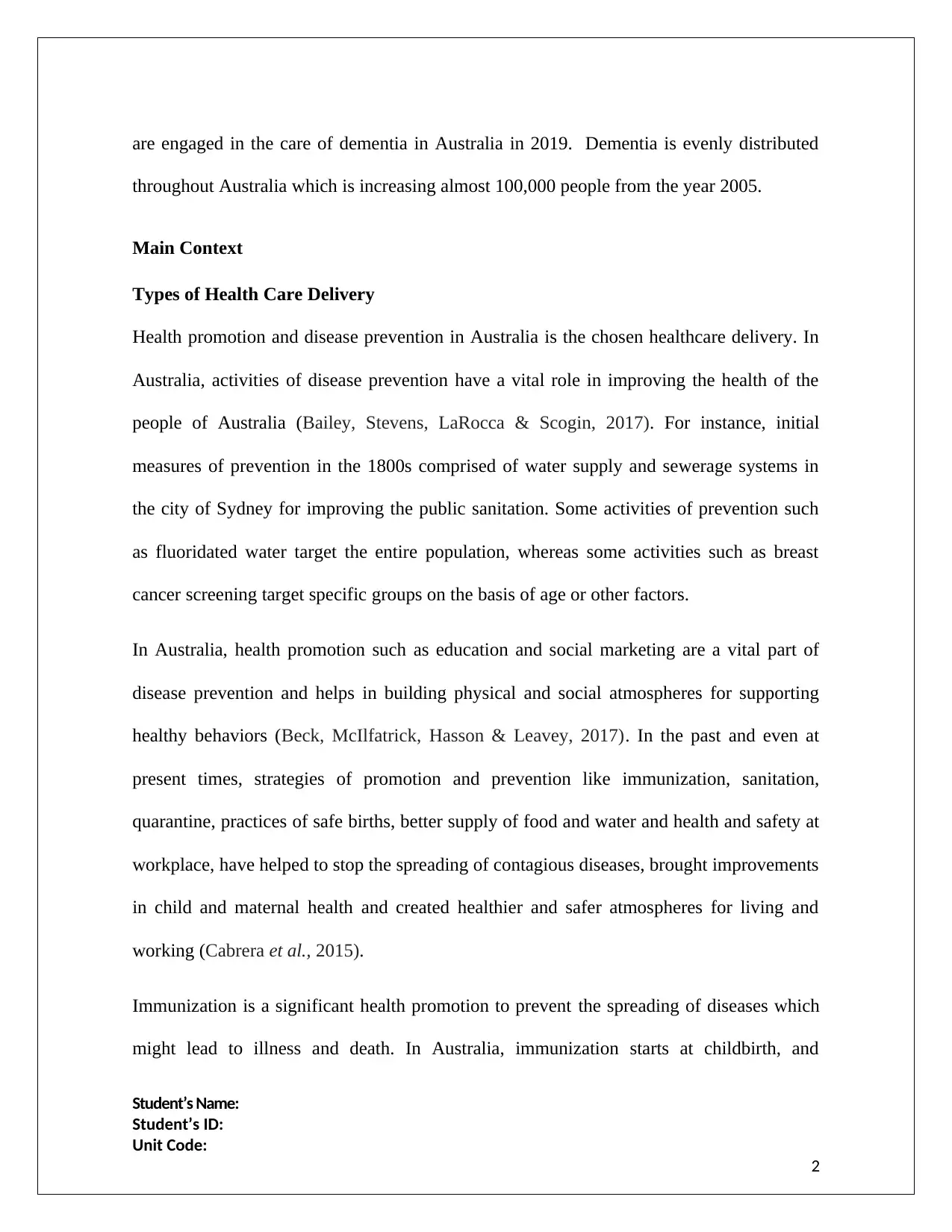
are engaged in the care of dementia in Australia in 2019. Dementia is evenly distributed
throughout Australia which is increasing almost 100,000 people from the year 2005.
Main Context
Types of Health Care Delivery
Health promotion and disease prevention in Australia is the chosen healthcare delivery. In
Australia, activities of disease prevention have a vital role in improving the health of the
people of Australia (Bailey, Stevens, LaRocca & Scogin, 2017). For instance, initial
measures of prevention in the 1800s comprised of water supply and sewerage systems in
the city of Sydney for improving the public sanitation. Some activities of prevention such
as fluoridated water target the entire population, whereas some activities such as breast
cancer screening target specific groups on the basis of age or other factors.
In Australia, health promotion such as education and social marketing are a vital part of
disease prevention and helps in building physical and social atmospheres for supporting
healthy behaviors (Beck, McIlfatrick, Hasson & Leavey, 2017). In the past and even at
present times, strategies of promotion and prevention like immunization, sanitation,
quarantine, practices of safe births, better supply of food and water and health and safety at
workplace, have helped to stop the spreading of contagious diseases, brought improvements
in child and maternal health and created healthier and safer atmospheres for living and
working (Cabrera et al., 2015).
Immunization is a significant health promotion to prevent the spreading of diseases which
might lead to illness and death. In Australia, immunization starts at childbirth, and
Student’s Name:
Student’s ID:
Unit Code:
2
throughout Australia which is increasing almost 100,000 people from the year 2005.
Main Context
Types of Health Care Delivery
Health promotion and disease prevention in Australia is the chosen healthcare delivery. In
Australia, activities of disease prevention have a vital role in improving the health of the
people of Australia (Bailey, Stevens, LaRocca & Scogin, 2017). For instance, initial
measures of prevention in the 1800s comprised of water supply and sewerage systems in
the city of Sydney for improving the public sanitation. Some activities of prevention such
as fluoridated water target the entire population, whereas some activities such as breast
cancer screening target specific groups on the basis of age or other factors.
In Australia, health promotion such as education and social marketing are a vital part of
disease prevention and helps in building physical and social atmospheres for supporting
healthy behaviors (Beck, McIlfatrick, Hasson & Leavey, 2017). In the past and even at
present times, strategies of promotion and prevention like immunization, sanitation,
quarantine, practices of safe births, better supply of food and water and health and safety at
workplace, have helped to stop the spreading of contagious diseases, brought improvements
in child and maternal health and created healthier and safer atmospheres for living and
working (Cabrera et al., 2015).
Immunization is a significant health promotion to prevent the spreading of diseases which
might lead to illness and death. In Australia, immunization starts at childbirth, and
Student’s Name:
Student’s ID:
Unit Code:
2
⊘ This is a preview!⊘
Do you want full access?
Subscribe today to unlock all pages.

Trusted by 1+ million students worldwide
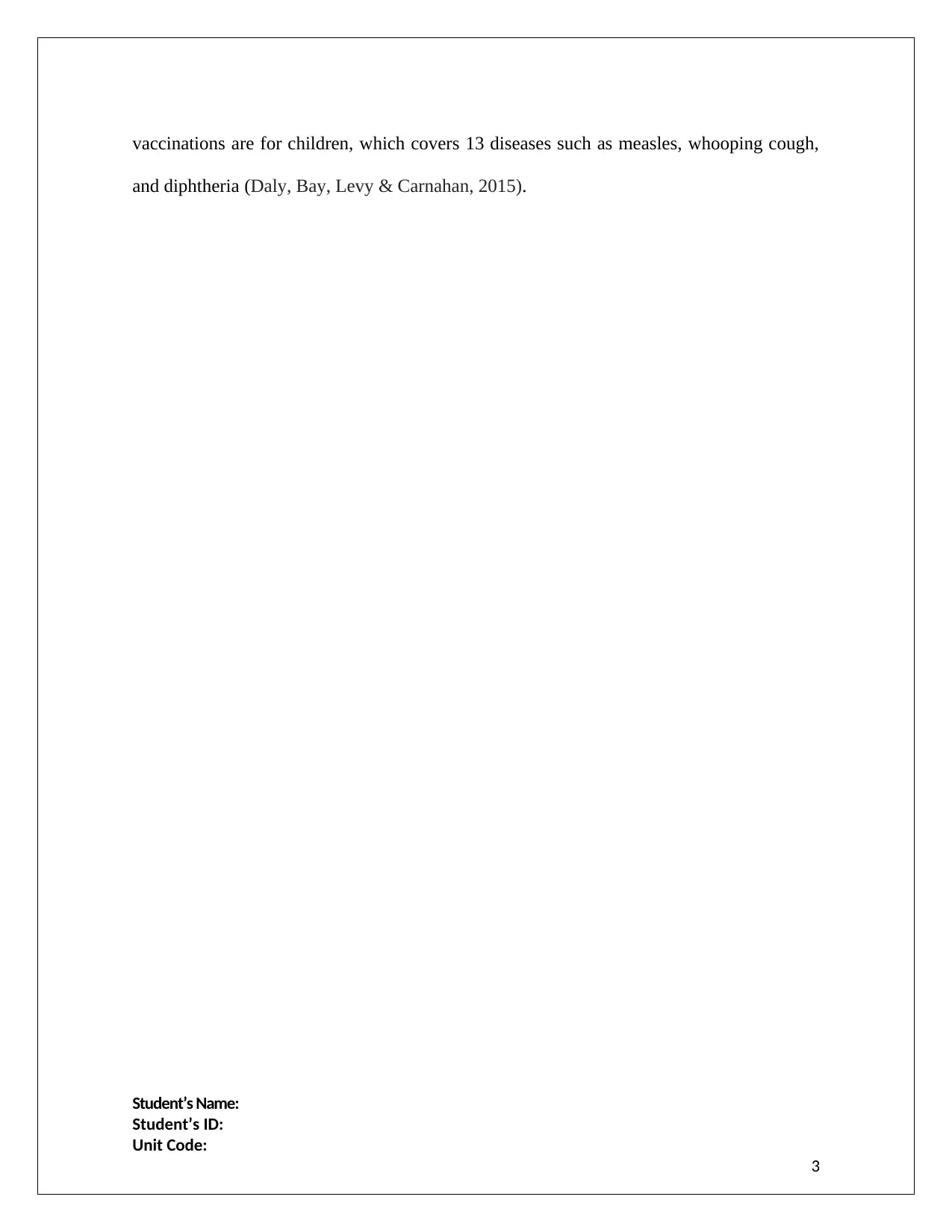
vaccinations are for children, which covers 13 diseases such as measles, whooping cough,
and diphtheria (Daly, Bay, Levy & Carnahan, 2015).
Student’s Name:
Student’s ID:
Unit Code:
3
and diphtheria (Daly, Bay, Levy & Carnahan, 2015).
Student’s Name:
Student’s ID:
Unit Code:
3
Paraphrase This Document
Need a fresh take? Get an instant paraphrase of this document with our AI Paraphraser
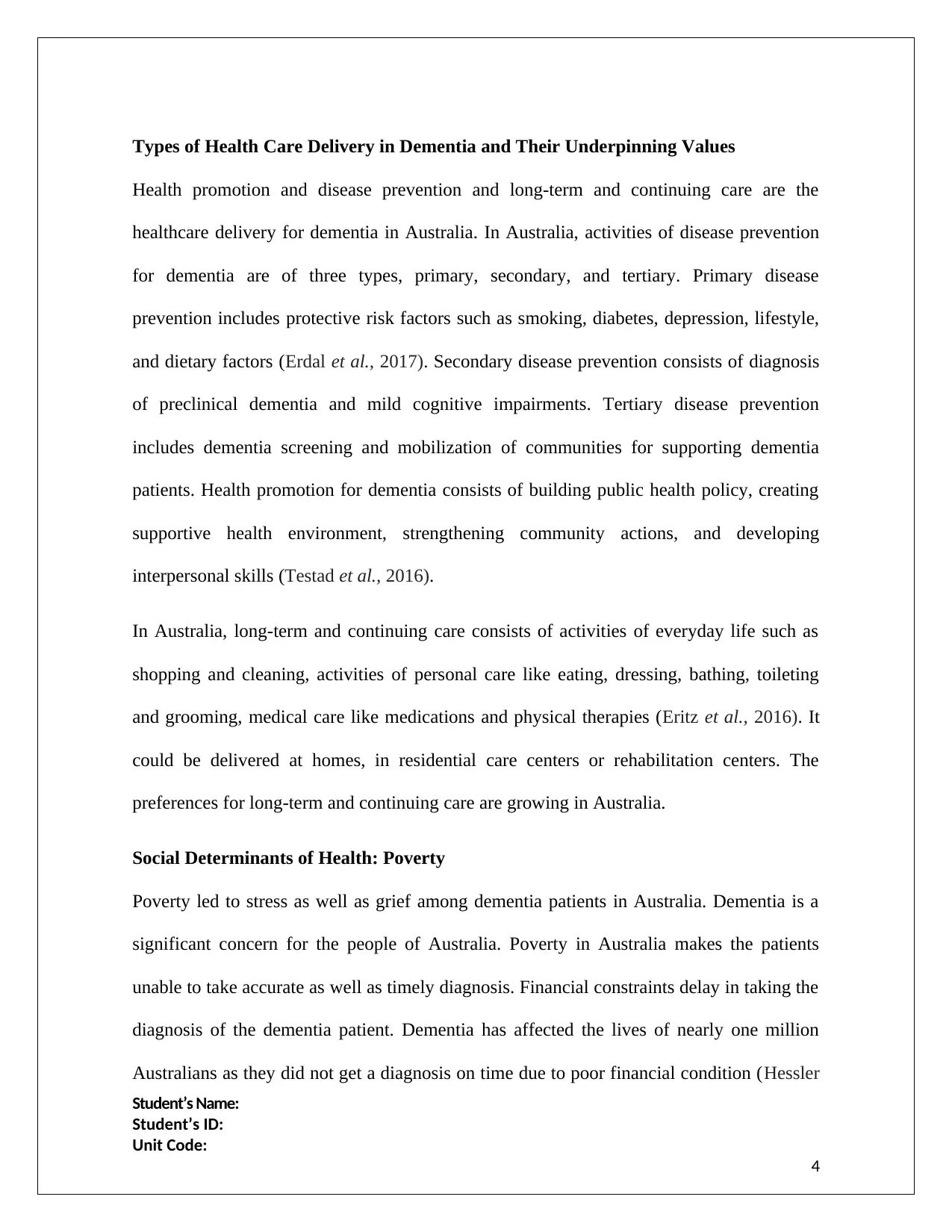
Types of Health Care Delivery in Dementia and Their Underpinning Values
Health promotion and disease prevention and long-term and continuing care are the
healthcare delivery for dementia in Australia. In Australia, activities of disease prevention
for dementia are of three types, primary, secondary, and tertiary. Primary disease
prevention includes protective risk factors such as smoking, diabetes, depression, lifestyle,
and dietary factors (Erdal et al., 2017). Secondary disease prevention consists of diagnosis
of preclinical dementia and mild cognitive impairments. Tertiary disease prevention
includes dementia screening and mobilization of communities for supporting dementia
patients. Health promotion for dementia consists of building public health policy, creating
supportive health environment, strengthening community actions, and developing
interpersonal skills (Testad et al., 2016).
In Australia, long-term and continuing care consists of activities of everyday life such as
shopping and cleaning, activities of personal care like eating, dressing, bathing, toileting
and grooming, medical care like medications and physical therapies (Eritz et al., 2016). It
could be delivered at homes, in residential care centers or rehabilitation centers. The
preferences for long-term and continuing care are growing in Australia.
Social Determinants of Health: Poverty
Poverty led to stress as well as grief among dementia patients in Australia. Dementia is a
significant concern for the people of Australia. Poverty in Australia makes the patients
unable to take accurate as well as timely diagnosis. Financial constraints delay in taking the
diagnosis of the dementia patient. Dementia has affected the lives of nearly one million
Australians as they did not get a diagnosis on time due to poor financial condition (Hessler
Student’s Name:
Student’s ID:
Unit Code:
4
Health promotion and disease prevention and long-term and continuing care are the
healthcare delivery for dementia in Australia. In Australia, activities of disease prevention
for dementia are of three types, primary, secondary, and tertiary. Primary disease
prevention includes protective risk factors such as smoking, diabetes, depression, lifestyle,
and dietary factors (Erdal et al., 2017). Secondary disease prevention consists of diagnosis
of preclinical dementia and mild cognitive impairments. Tertiary disease prevention
includes dementia screening and mobilization of communities for supporting dementia
patients. Health promotion for dementia consists of building public health policy, creating
supportive health environment, strengthening community actions, and developing
interpersonal skills (Testad et al., 2016).
In Australia, long-term and continuing care consists of activities of everyday life such as
shopping and cleaning, activities of personal care like eating, dressing, bathing, toileting
and grooming, medical care like medications and physical therapies (Eritz et al., 2016). It
could be delivered at homes, in residential care centers or rehabilitation centers. The
preferences for long-term and continuing care are growing in Australia.
Social Determinants of Health: Poverty
Poverty led to stress as well as grief among dementia patients in Australia. Dementia is a
significant concern for the people of Australia. Poverty in Australia makes the patients
unable to take accurate as well as timely diagnosis. Financial constraints delay in taking the
diagnosis of the dementia patient. Dementia has affected the lives of nearly one million
Australians as they did not get a diagnosis on time due to poor financial condition (Hessler
Student’s Name:
Student’s ID:
Unit Code:
4
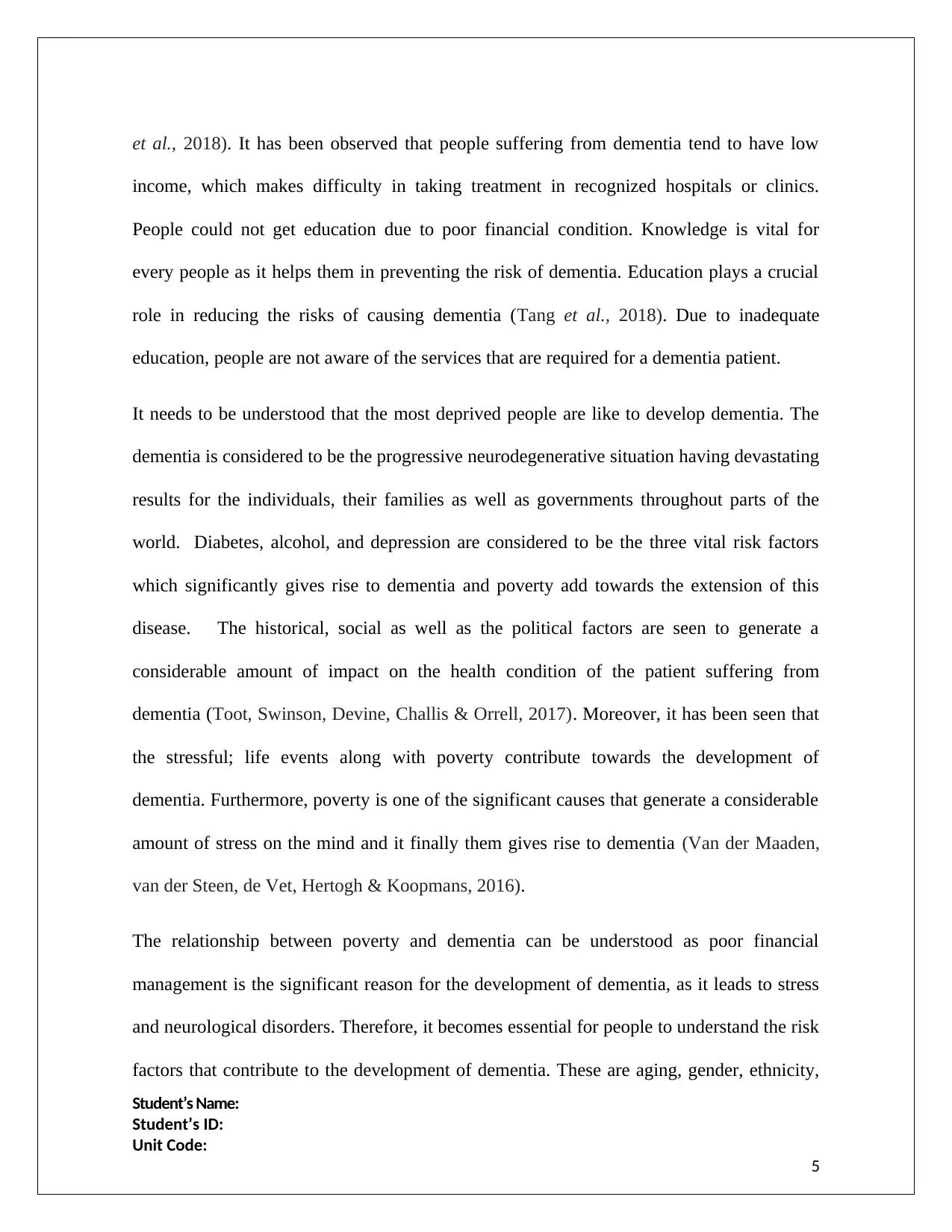
et al., 2018). It has been observed that people suffering from dementia tend to have low
income, which makes difficulty in taking treatment in recognized hospitals or clinics.
People could not get education due to poor financial condition. Knowledge is vital for
every people as it helps them in preventing the risk of dementia. Education plays a crucial
role in reducing the risks of causing dementia (Tang et al., 2018). Due to inadequate
education, people are not aware of the services that are required for a dementia patient.
It needs to be understood that the most deprived people are like to develop dementia. The
dementia is considered to be the progressive neurodegenerative situation having devastating
results for the individuals, their families as well as governments throughout parts of the
world. Diabetes, alcohol, and depression are considered to be the three vital risk factors
which significantly gives rise to dementia and poverty add towards the extension of this
disease. The historical, social as well as the political factors are seen to generate a
considerable amount of impact on the health condition of the patient suffering from
dementia (Toot, Swinson, Devine, Challis & Orrell, 2017). Moreover, it has been seen that
the stressful; life events along with poverty contribute towards the development of
dementia. Furthermore, poverty is one of the significant causes that generate a considerable
amount of stress on the mind and it finally them gives rise to dementia (Van der Maaden,
van der Steen, de Vet, Hertogh & Koopmans, 2016).
The relationship between poverty and dementia can be understood as poor financial
management is the significant reason for the development of dementia, as it leads to stress
and neurological disorders. Therefore, it becomes essential for people to understand the risk
factors that contribute to the development of dementia. These are aging, gender, ethnicity,
Student’s Name:
Student’s ID:
Unit Code:
5
income, which makes difficulty in taking treatment in recognized hospitals or clinics.
People could not get education due to poor financial condition. Knowledge is vital for
every people as it helps them in preventing the risk of dementia. Education plays a crucial
role in reducing the risks of causing dementia (Tang et al., 2018). Due to inadequate
education, people are not aware of the services that are required for a dementia patient.
It needs to be understood that the most deprived people are like to develop dementia. The
dementia is considered to be the progressive neurodegenerative situation having devastating
results for the individuals, their families as well as governments throughout parts of the
world. Diabetes, alcohol, and depression are considered to be the three vital risk factors
which significantly gives rise to dementia and poverty add towards the extension of this
disease. The historical, social as well as the political factors are seen to generate a
considerable amount of impact on the health condition of the patient suffering from
dementia (Toot, Swinson, Devine, Challis & Orrell, 2017). Moreover, it has been seen that
the stressful; life events along with poverty contribute towards the development of
dementia. Furthermore, poverty is one of the significant causes that generate a considerable
amount of stress on the mind and it finally them gives rise to dementia (Van der Maaden,
van der Steen, de Vet, Hertogh & Koopmans, 2016).
The relationship between poverty and dementia can be understood as poor financial
management is the significant reason for the development of dementia, as it leads to stress
and neurological disorders. Therefore, it becomes essential for people to understand the risk
factors that contribute to the development of dementia. These are aging, gender, ethnicity,
Student’s Name:
Student’s ID:
Unit Code:
5
⊘ This is a preview!⊘
Do you want full access?
Subscribe today to unlock all pages.

Trusted by 1+ million students worldwide
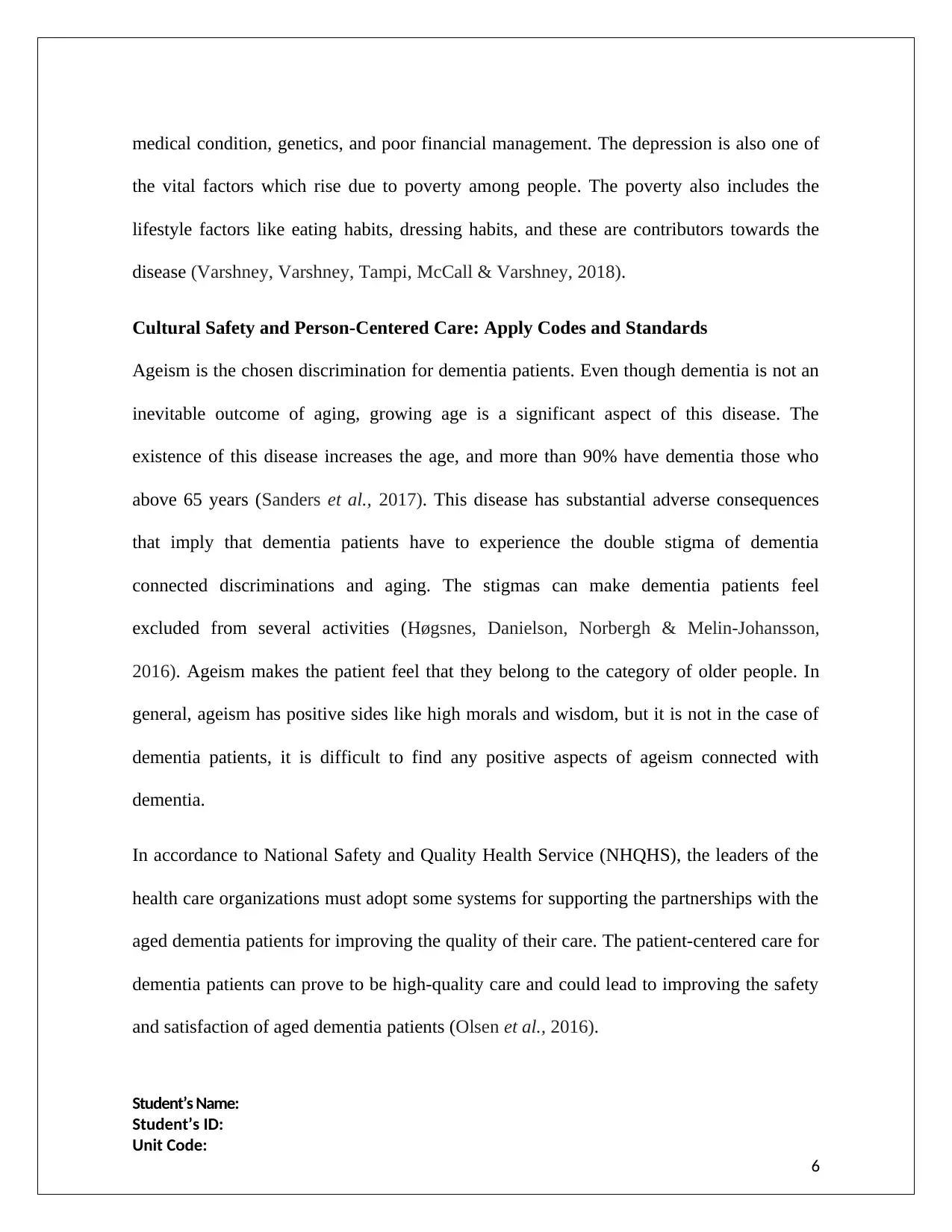
medical condition, genetics, and poor financial management. The depression is also one of
the vital factors which rise due to poverty among people. The poverty also includes the
lifestyle factors like eating habits, dressing habits, and these are contributors towards the
disease (Varshney, Varshney, Tampi, McCall & Varshney, 2018).
Cultural Safety and Person-Centered Care: Apply Codes and Standards
Ageism is the chosen discrimination for dementia patients. Even though dementia is not an
inevitable outcome of aging, growing age is a significant aspect of this disease. The
existence of this disease increases the age, and more than 90% have dementia those who
above 65 years (Sanders et al., 2017). This disease has substantial adverse consequences
that imply that dementia patients have to experience the double stigma of dementia
connected discriminations and aging. The stigmas can make dementia patients feel
excluded from several activities (Høgsnes, Danielson, Norbergh & Melin‐Johansson,
2016). Ageism makes the patient feel that they belong to the category of older people. In
general, ageism has positive sides like high morals and wisdom, but it is not in the case of
dementia patients, it is difficult to find any positive aspects of ageism connected with
dementia.
In accordance to National Safety and Quality Health Service (NHQHS), the leaders of the
health care organizations must adopt some systems for supporting the partnerships with the
aged dementia patients for improving the quality of their care. The patient-centered care for
dementia patients can prove to be high-quality care and could lead to improving the safety
and satisfaction of aged dementia patients (Olsen et al., 2016).
Student’s Name:
Student’s ID:
Unit Code:
6
the vital factors which rise due to poverty among people. The poverty also includes the
lifestyle factors like eating habits, dressing habits, and these are contributors towards the
disease (Varshney, Varshney, Tampi, McCall & Varshney, 2018).
Cultural Safety and Person-Centered Care: Apply Codes and Standards
Ageism is the chosen discrimination for dementia patients. Even though dementia is not an
inevitable outcome of aging, growing age is a significant aspect of this disease. The
existence of this disease increases the age, and more than 90% have dementia those who
above 65 years (Sanders et al., 2017). This disease has substantial adverse consequences
that imply that dementia patients have to experience the double stigma of dementia
connected discriminations and aging. The stigmas can make dementia patients feel
excluded from several activities (Høgsnes, Danielson, Norbergh & Melin‐Johansson,
2016). Ageism makes the patient feel that they belong to the category of older people. In
general, ageism has positive sides like high morals and wisdom, but it is not in the case of
dementia patients, it is difficult to find any positive aspects of ageism connected with
dementia.
In accordance to National Safety and Quality Health Service (NHQHS), the leaders of the
health care organizations must adopt some systems for supporting the partnerships with the
aged dementia patients for improving the quality of their care. The patient-centered care for
dementia patients can prove to be high-quality care and could lead to improving the safety
and satisfaction of aged dementia patients (Olsen et al., 2016).
Student’s Name:
Student’s ID:
Unit Code:
6
Paraphrase This Document
Need a fresh take? Get an instant paraphrase of this document with our AI Paraphraser
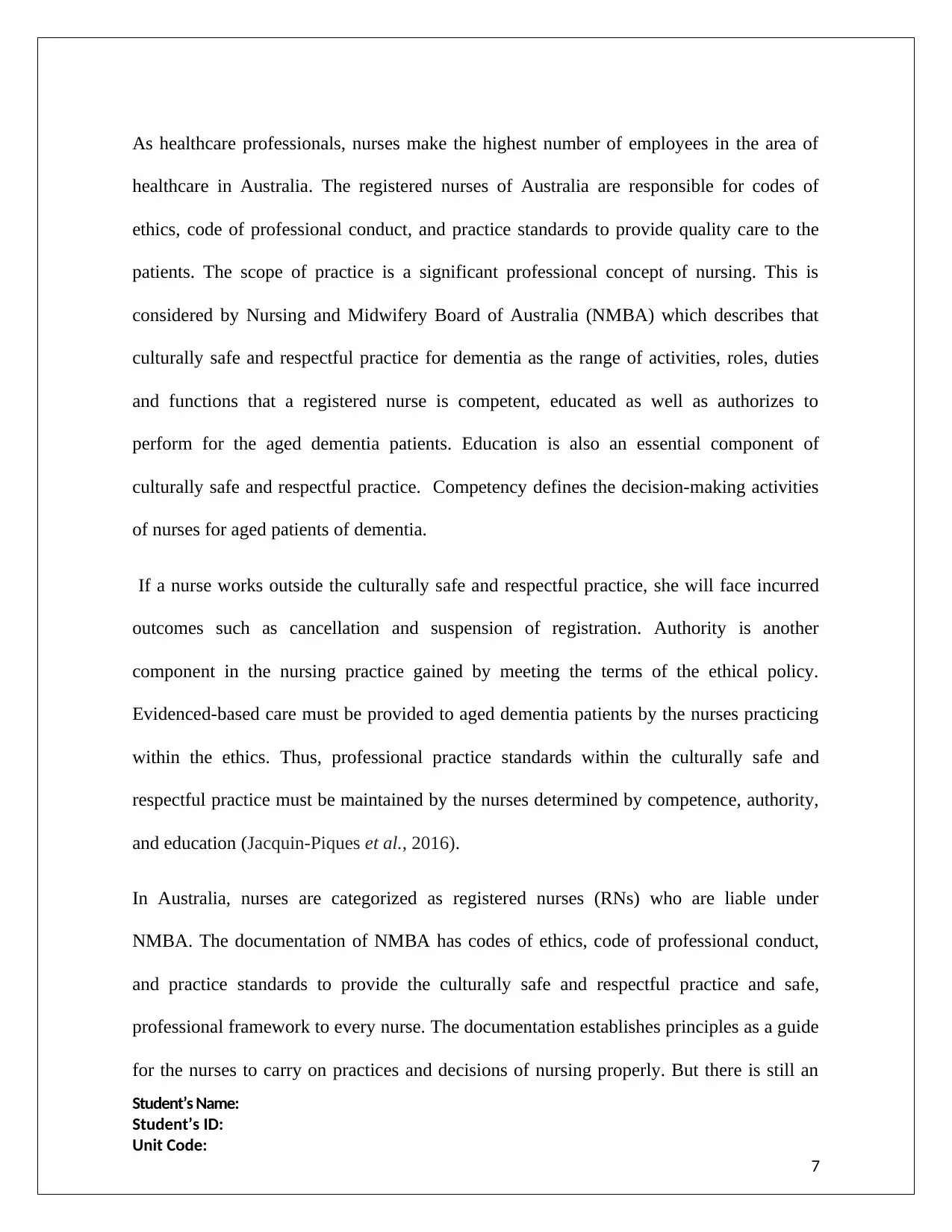
As healthcare professionals, nurses make the highest number of employees in the area of
healthcare in Australia. The registered nurses of Australia are responsible for codes of
ethics, code of professional conduct, and practice standards to provide quality care to the
patients. The scope of practice is a significant professional concept of nursing. This is
considered by Nursing and Midwifery Board of Australia (NMBA) which describes that
culturally safe and respectful practice for dementia as the range of activities, roles, duties
and functions that a registered nurse is competent, educated as well as authorizes to
perform for the aged dementia patients. Education is also an essential component of
culturally safe and respectful practice. Competency defines the decision-making activities
of nurses for aged patients of dementia.
If a nurse works outside the culturally safe and respectful practice, she will face incurred
outcomes such as cancellation and suspension of registration. Authority is another
component in the nursing practice gained by meeting the terms of the ethical policy.
Evidenced-based care must be provided to aged dementia patients by the nurses practicing
within the ethics. Thus, professional practice standards within the culturally safe and
respectful practice must be maintained by the nurses determined by competence, authority,
and education (Jacquin-Piques et al., 2016).
In Australia, nurses are categorized as registered nurses (RNs) who are liable under
NMBA. The documentation of NMBA has codes of ethics, code of professional conduct,
and practice standards to provide the culturally safe and respectful practice and safe,
professional framework to every nurse. The documentation establishes principles as a guide
for the nurses to carry on practices and decisions of nursing properly. But there is still an
Student’s Name:
Student’s ID:
Unit Code:
7
healthcare in Australia. The registered nurses of Australia are responsible for codes of
ethics, code of professional conduct, and practice standards to provide quality care to the
patients. The scope of practice is a significant professional concept of nursing. This is
considered by Nursing and Midwifery Board of Australia (NMBA) which describes that
culturally safe and respectful practice for dementia as the range of activities, roles, duties
and functions that a registered nurse is competent, educated as well as authorizes to
perform for the aged dementia patients. Education is also an essential component of
culturally safe and respectful practice. Competency defines the decision-making activities
of nurses for aged patients of dementia.
If a nurse works outside the culturally safe and respectful practice, she will face incurred
outcomes such as cancellation and suspension of registration. Authority is another
component in the nursing practice gained by meeting the terms of the ethical policy.
Evidenced-based care must be provided to aged dementia patients by the nurses practicing
within the ethics. Thus, professional practice standards within the culturally safe and
respectful practice must be maintained by the nurses determined by competence, authority,
and education (Jacquin-Piques et al., 2016).
In Australia, nurses are categorized as registered nurses (RNs) who are liable under
NMBA. The documentation of NMBA has codes of ethics, code of professional conduct,
and practice standards to provide the culturally safe and respectful practice and safe,
professional framework to every nurse. The documentation establishes principles as a guide
for the nurses to carry on practices and decisions of nursing properly. But there is still an
Student’s Name:
Student’s ID:
Unit Code:
7
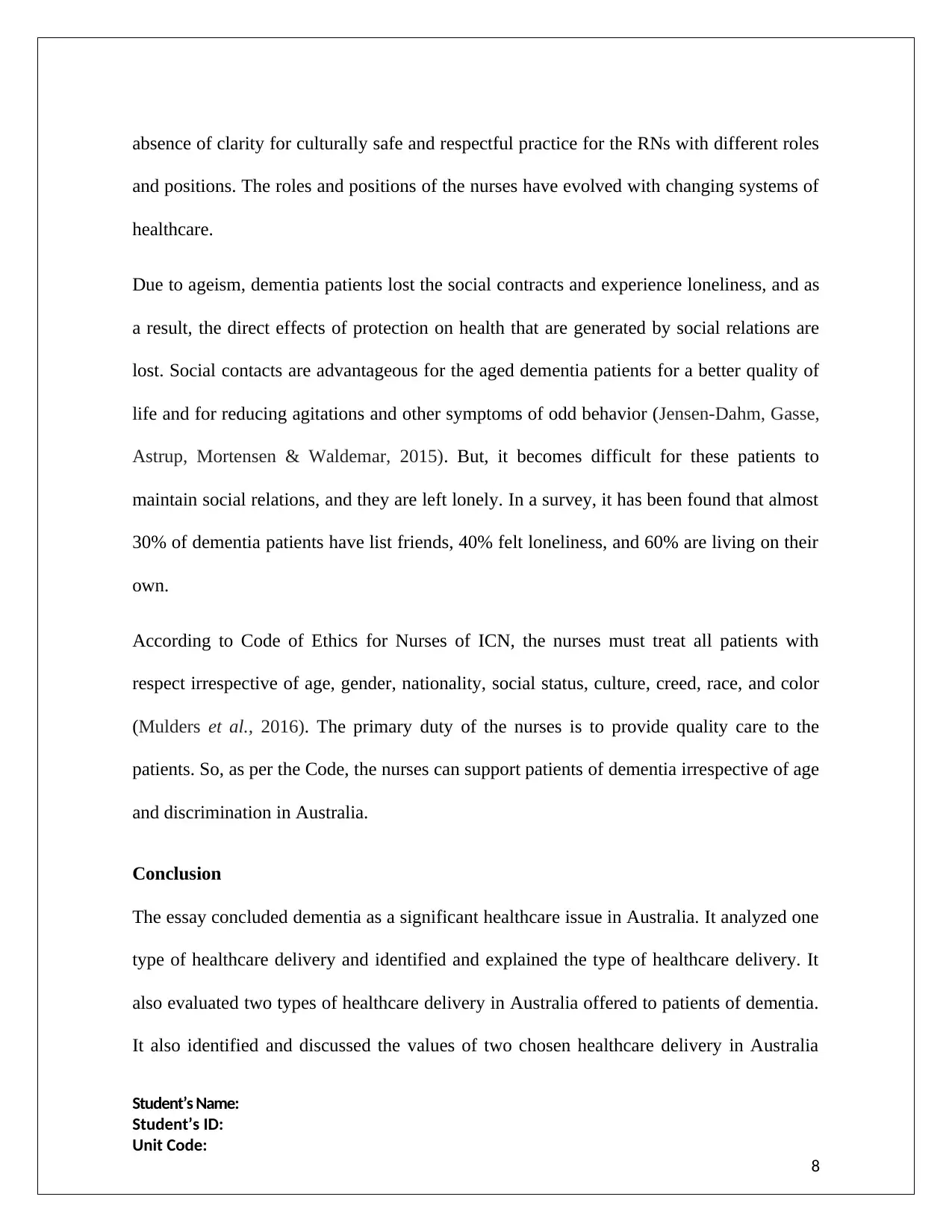
absence of clarity for culturally safe and respectful practice for the RNs with different roles
and positions. The roles and positions of the nurses have evolved with changing systems of
healthcare.
Due to ageism, dementia patients lost the social contracts and experience loneliness, and as
a result, the direct effects of protection on health that are generated by social relations are
lost. Social contacts are advantageous for the aged dementia patients for a better quality of
life and for reducing agitations and other symptoms of odd behavior (Jensen-Dahm, Gasse,
Astrup, Mortensen & Waldemar, 2015). But, it becomes difficult for these patients to
maintain social relations, and they are left lonely. In a survey, it has been found that almost
30% of dementia patients have list friends, 40% felt loneliness, and 60% are living on their
own.
According to Code of Ethics for Nurses of ICN, the nurses must treat all patients with
respect irrespective of age, gender, nationality, social status, culture, creed, race, and color
(Mulders et al., 2016). The primary duty of the nurses is to provide quality care to the
patients. So, as per the Code, the nurses can support patients of dementia irrespective of age
and discrimination in Australia.
Conclusion
The essay concluded dementia as a significant healthcare issue in Australia. It analyzed one
type of healthcare delivery and identified and explained the type of healthcare delivery. It
also evaluated two types of healthcare delivery in Australia offered to patients of dementia.
It also identified and discussed the values of two chosen healthcare delivery in Australia
Student’s Name:
Student’s ID:
Unit Code:
8
and positions. The roles and positions of the nurses have evolved with changing systems of
healthcare.
Due to ageism, dementia patients lost the social contracts and experience loneliness, and as
a result, the direct effects of protection on health that are generated by social relations are
lost. Social contacts are advantageous for the aged dementia patients for a better quality of
life and for reducing agitations and other symptoms of odd behavior (Jensen-Dahm, Gasse,
Astrup, Mortensen & Waldemar, 2015). But, it becomes difficult for these patients to
maintain social relations, and they are left lonely. In a survey, it has been found that almost
30% of dementia patients have list friends, 40% felt loneliness, and 60% are living on their
own.
According to Code of Ethics for Nurses of ICN, the nurses must treat all patients with
respect irrespective of age, gender, nationality, social status, culture, creed, race, and color
(Mulders et al., 2016). The primary duty of the nurses is to provide quality care to the
patients. So, as per the Code, the nurses can support patients of dementia irrespective of age
and discrimination in Australia.
Conclusion
The essay concluded dementia as a significant healthcare issue in Australia. It analyzed one
type of healthcare delivery and identified and explained the type of healthcare delivery. It
also evaluated two types of healthcare delivery in Australia offered to patients of dementia.
It also identified and discussed the values of two chosen healthcare delivery in Australia
Student’s Name:
Student’s ID:
Unit Code:
8
⊘ This is a preview!⊘
Do you want full access?
Subscribe today to unlock all pages.

Trusted by 1+ million students worldwide
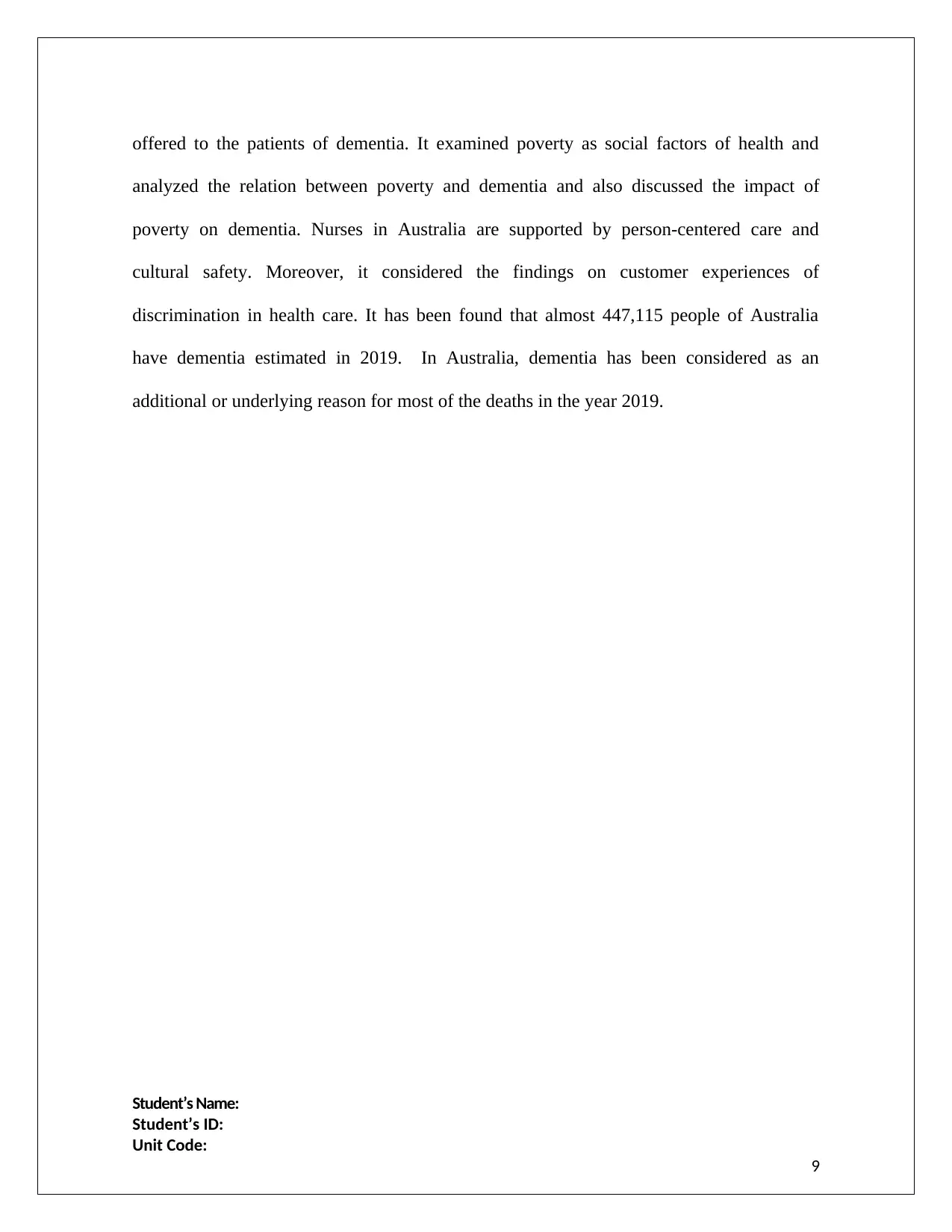
offered to the patients of dementia. It examined poverty as social factors of health and
analyzed the relation between poverty and dementia and also discussed the impact of
poverty on dementia. Nurses in Australia are supported by person-centered care and
cultural safety. Moreover, it considered the findings on customer experiences of
discrimination in health care. It has been found that almost 447,115 people of Australia
have dementia estimated in 2019. In Australia, dementia has been considered as an
additional or underlying reason for most of the deaths in the year 2019.
Student’s Name:
Student’s ID:
Unit Code:
9
analyzed the relation between poverty and dementia and also discussed the impact of
poverty on dementia. Nurses in Australia are supported by person-centered care and
cultural safety. Moreover, it considered the findings on customer experiences of
discrimination in health care. It has been found that almost 447,115 people of Australia
have dementia estimated in 2019. In Australia, dementia has been considered as an
additional or underlying reason for most of the deaths in the year 2019.
Student’s Name:
Student’s ID:
Unit Code:
9
Paraphrase This Document
Need a fresh take? Get an instant paraphrase of this document with our AI Paraphraser
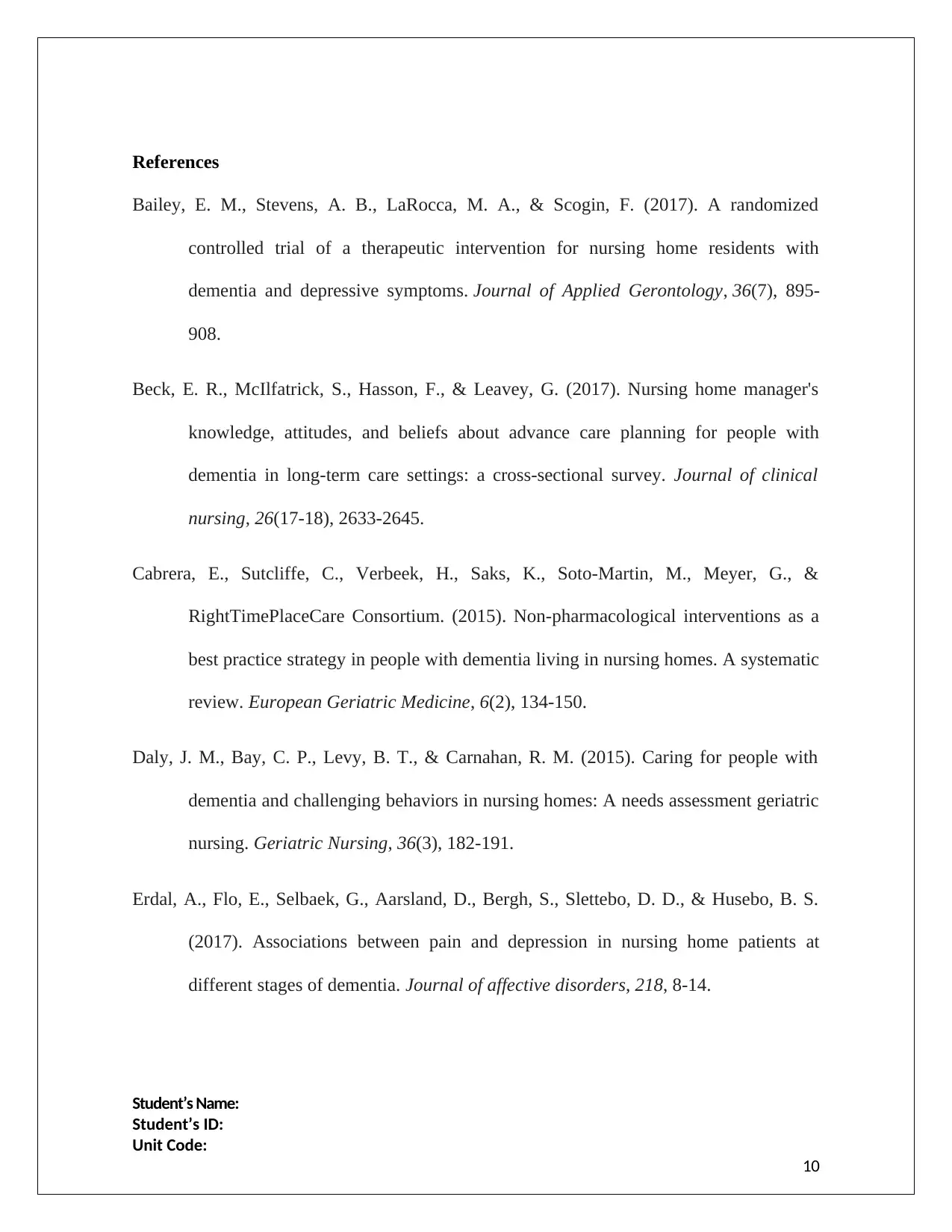
References
Bailey, E. M., Stevens, A. B., LaRocca, M. A., & Scogin, F. (2017). A randomized
controlled trial of a therapeutic intervention for nursing home residents with
dementia and depressive symptoms. Journal of Applied Gerontology, 36(7), 895-
908.
Beck, E. R., McIlfatrick, S., Hasson, F., & Leavey, G. (2017). Nursing home manager's
knowledge, attitudes, and beliefs about advance care planning for people with
dementia in long‐term care settings: a cross‐sectional survey. Journal of clinical
nursing, 26(17-18), 2633-2645.
Cabrera, E., Sutcliffe, C., Verbeek, H., Saks, K., Soto-Martin, M., Meyer, G., &
RightTimePlaceCare Consortium. (2015). Non-pharmacological interventions as a
best practice strategy in people with dementia living in nursing homes. A systematic
review. European Geriatric Medicine, 6(2), 134-150.
Daly, J. M., Bay, C. P., Levy, B. T., & Carnahan, R. M. (2015). Caring for people with
dementia and challenging behaviors in nursing homes: A needs assessment geriatric
nursing. Geriatric Nursing, 36(3), 182-191.
Erdal, A., Flo, E., Selbaek, G., Aarsland, D., Bergh, S., Slettebo, D. D., & Husebo, B. S.
(2017). Associations between pain and depression in nursing home patients at
different stages of dementia. Journal of affective disorders, 218, 8-14.
Student’s Name:
Student’s ID:
Unit Code:
10
Bailey, E. M., Stevens, A. B., LaRocca, M. A., & Scogin, F. (2017). A randomized
controlled trial of a therapeutic intervention for nursing home residents with
dementia and depressive symptoms. Journal of Applied Gerontology, 36(7), 895-
908.
Beck, E. R., McIlfatrick, S., Hasson, F., & Leavey, G. (2017). Nursing home manager's
knowledge, attitudes, and beliefs about advance care planning for people with
dementia in long‐term care settings: a cross‐sectional survey. Journal of clinical
nursing, 26(17-18), 2633-2645.
Cabrera, E., Sutcliffe, C., Verbeek, H., Saks, K., Soto-Martin, M., Meyer, G., &
RightTimePlaceCare Consortium. (2015). Non-pharmacological interventions as a
best practice strategy in people with dementia living in nursing homes. A systematic
review. European Geriatric Medicine, 6(2), 134-150.
Daly, J. M., Bay, C. P., Levy, B. T., & Carnahan, R. M. (2015). Caring for people with
dementia and challenging behaviors in nursing homes: A needs assessment geriatric
nursing. Geriatric Nursing, 36(3), 182-191.
Erdal, A., Flo, E., Selbaek, G., Aarsland, D., Bergh, S., Slettebo, D. D., & Husebo, B. S.
(2017). Associations between pain and depression in nursing home patients at
different stages of dementia. Journal of affective disorders, 218, 8-14.
Student’s Name:
Student’s ID:
Unit Code:
10
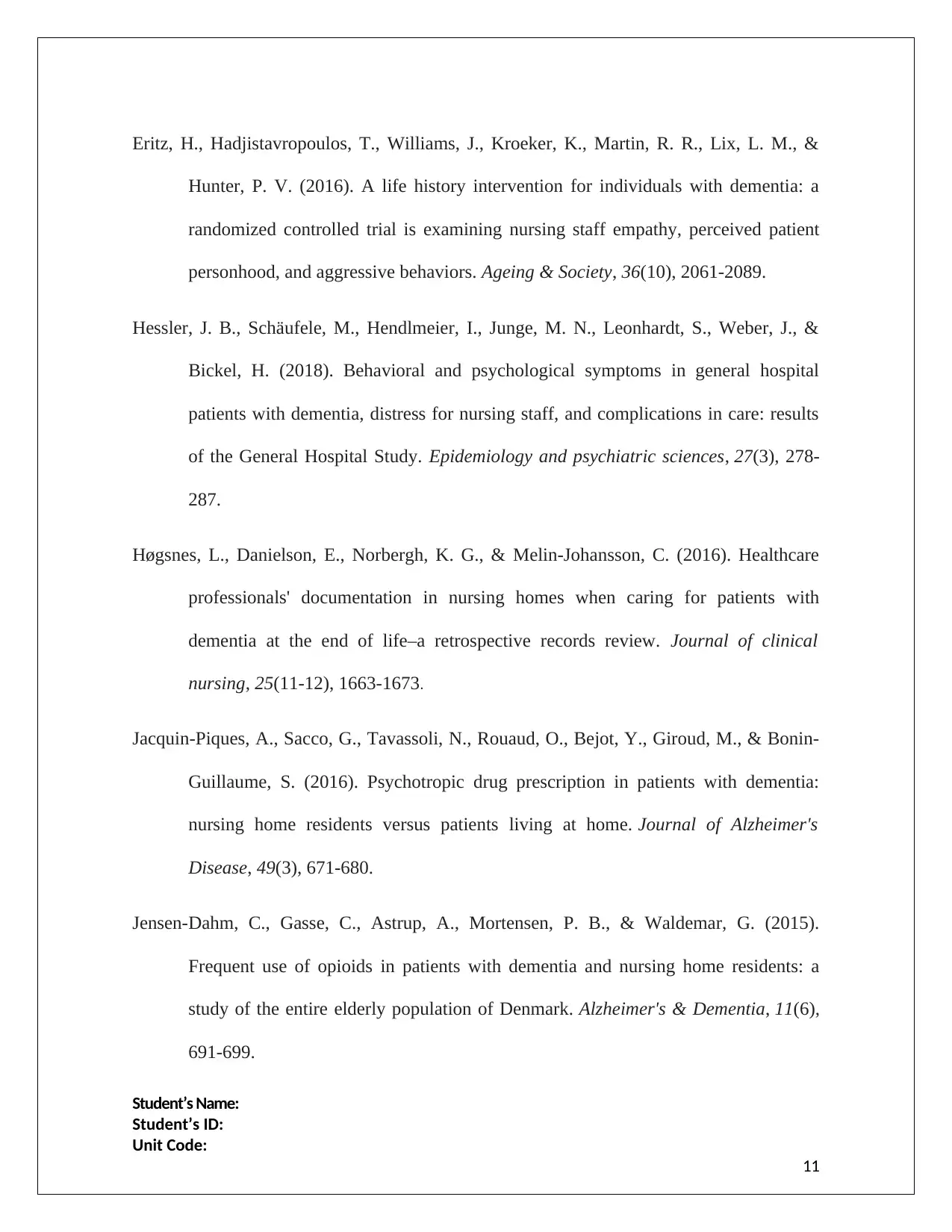
Eritz, H., Hadjistavropoulos, T., Williams, J., Kroeker, K., Martin, R. R., Lix, L. M., &
Hunter, P. V. (2016). A life history intervention for individuals with dementia: a
randomized controlled trial is examining nursing staff empathy, perceived patient
personhood, and aggressive behaviors. Ageing & Society, 36(10), 2061-2089.
Hessler, J. B., Schäufele, M., Hendlmeier, I., Junge, M. N., Leonhardt, S., Weber, J., &
Bickel, H. (2018). Behavioral and psychological symptoms in general hospital
patients with dementia, distress for nursing staff, and complications in care: results
of the General Hospital Study. Epidemiology and psychiatric sciences, 27(3), 278-
287.
Høgsnes, L., Danielson, E., Norbergh, K. G., & Melin‐Johansson, C. (2016). Healthcare
professionals' documentation in nursing homes when caring for patients with
dementia at the end of life–a retrospective records review. Journal of clinical
nursing, 25(11-12), 1663-1673.
Jacquin-Piques, A., Sacco, G., Tavassoli, N., Rouaud, O., Bejot, Y., Giroud, M., & Bonin-
Guillaume, S. (2016). Psychotropic drug prescription in patients with dementia:
nursing home residents versus patients living at home. Journal of Alzheimer's
Disease, 49(3), 671-680.
Jensen-Dahm, C., Gasse, C., Astrup, A., Mortensen, P. B., & Waldemar, G. (2015).
Frequent use of opioids in patients with dementia and nursing home residents: a
study of the entire elderly population of Denmark. Alzheimer's & Dementia, 11(6),
691-699.
Student’s Name:
Student’s ID:
Unit Code:
11
Hunter, P. V. (2016). A life history intervention for individuals with dementia: a
randomized controlled trial is examining nursing staff empathy, perceived patient
personhood, and aggressive behaviors. Ageing & Society, 36(10), 2061-2089.
Hessler, J. B., Schäufele, M., Hendlmeier, I., Junge, M. N., Leonhardt, S., Weber, J., &
Bickel, H. (2018). Behavioral and psychological symptoms in general hospital
patients with dementia, distress for nursing staff, and complications in care: results
of the General Hospital Study. Epidemiology and psychiatric sciences, 27(3), 278-
287.
Høgsnes, L., Danielson, E., Norbergh, K. G., & Melin‐Johansson, C. (2016). Healthcare
professionals' documentation in nursing homes when caring for patients with
dementia at the end of life–a retrospective records review. Journal of clinical
nursing, 25(11-12), 1663-1673.
Jacquin-Piques, A., Sacco, G., Tavassoli, N., Rouaud, O., Bejot, Y., Giroud, M., & Bonin-
Guillaume, S. (2016). Psychotropic drug prescription in patients with dementia:
nursing home residents versus patients living at home. Journal of Alzheimer's
Disease, 49(3), 671-680.
Jensen-Dahm, C., Gasse, C., Astrup, A., Mortensen, P. B., & Waldemar, G. (2015).
Frequent use of opioids in patients with dementia and nursing home residents: a
study of the entire elderly population of Denmark. Alzheimer's & Dementia, 11(6),
691-699.
Student’s Name:
Student’s ID:
Unit Code:
11
⊘ This is a preview!⊘
Do you want full access?
Subscribe today to unlock all pages.

Trusted by 1+ million students worldwide
1 out of 14
Related Documents
Your All-in-One AI-Powered Toolkit for Academic Success.
+13062052269
info@desklib.com
Available 24*7 on WhatsApp / Email
![[object Object]](/_next/static/media/star-bottom.7253800d.svg)
Unlock your academic potential
Copyright © 2020–2025 A2Z Services. All Rights Reserved. Developed and managed by ZUCOL.





